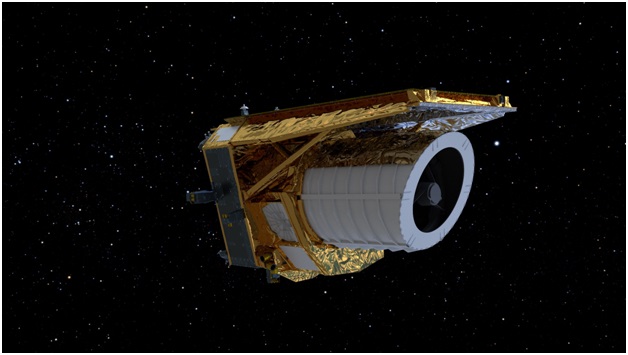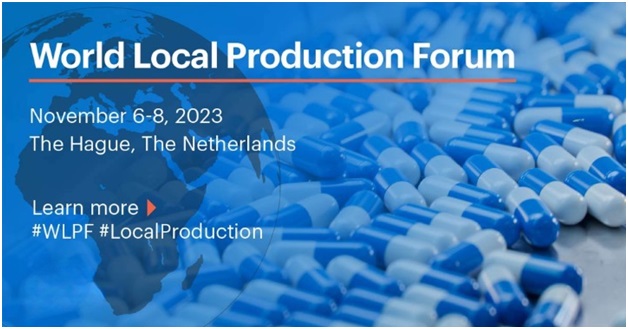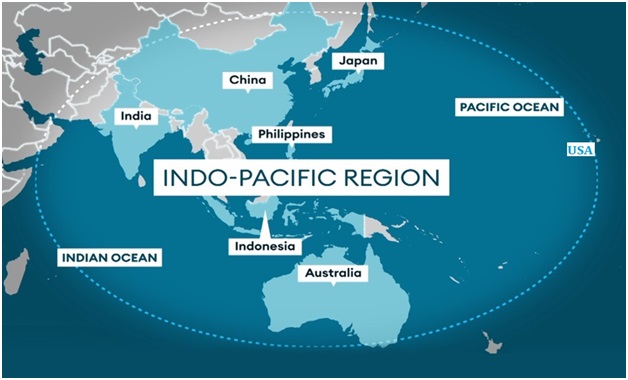Euclid Mission (NASA)

- 07 Nov 2023
Why in the News?
The Euclid mission, which will investigate the mysteries of dark matter and dark energy, released its first five science images recently.
About Euclid Mission:
- Euclid is a European mission, built and operated by European Space Agency (ESA), with contributions from NASA.
- Euclid is designed to give important new insights into the "dark side" of the universe -- namely dark matter and dark energy, both thought to be key components of our cosmos.
- It was launched from Cape Canaveral, Florida, (USA) on 1 July 2023 and the launch vehicle used was ‘SpaceX Falcon 9’.
- The mission derives its name from Euclid of Alexandria, an ancient Greek mathematician from around 300 BC, who laid the foundations of geometry.
- Euclid Mission Objective: The primary goal of the Euclid mission is to create a three-dimensional map of the universe, with time as the third dimension.
- This will be achieved by observing billions of galaxies, extending up to 10 billion light-years away, and covering over a third of the celestial sphere.
- Euclid will explore how the Universe has expanded and how structure has formed over cosmic history, revealing more about the role of gravity and the nature of dark energy and dark matter.
- The Euclid Consortium – consisting of more than 2,000 scientists from 300 institutes in 13 European countries, the U.S., Canada, and Japan – is responsible for providing the scientific instruments and scientific data analysis.
- NASA provided the detectors of the Near-Infrared Spectrometer and Photometer, NISP.
- Euclid is a medium-class mission in ESA’s Cosmic Vision Programme.
World Local Production Forum (WLPF) (PIB)

- 07 Nov 2023
Why in the News?
The Indian delegation led by Shri Bhagwant Khuba, Union Minister of State for Chemicals and Fertilizers participated in the Second World Local Production Forum (WLPF) held in Hague, Netherlands.
About the World Local Production Forum (WLPF):
- The World Local Production Forum (WLPF) is an initiative by the World Health Organization (WHO).
- The inaugural WLPF took place virtually in 2021.
- Main Objective: The core aim of this forum is to enhance access to essential medicines and other health technologies.
- Role and Function: The WLPF serves as a regular platform for Member States and the global community to collaboratively develop strategies, mobilize collective efforts, and establish partnerships.
- These actions are directed towards promoting sustainable local production, ensuring timely and equitable access to high-quality health products.
- Secretariat: The Local Production and Assistance (LPA) Unit at the WLPF is responsible for overseeing the forum's activities.
- Second WLPF Goals: The second WLPF has several key objectives:
- To create a global platform for discussions addressing the primary challenges related to local production and technology transfer.
- To explore opportunities and mechanisms for overcoming obstacles in this regard.
- To champion sustainable local production capabilities that lead to improved access to safe, effective, and high-quality health products and technologies.
Indo-Pacific Maritime Domain Awareness (IPMDA) initiative (The Hindu)

- 07 Nov 2023
Why in the News?
The Indian Navy Chief Admiral recently stated that the Indo-Pacific Maritime Domain Awareness (IPMDA) effort demonstrates the commitment to a free, open, inclusive, and rules-based Indo-Pacific region.
About the Indo-Pacific Maritime Domain Awareness (IPMDA) initiative:
- Announcement: It was announced at the 2022 Quad Leaders’ Summit in Tokyo.
- The primary objective is to track "dark shipping" and develop a more comprehensive, timely, and precise understanding of maritime activities in the Indo-Pacific region.
- Geographic Coverage: IPMDA integrates three critical regions in the Indo-Pacific:
- the Pacific Islands, Southeast Asia, and the Indian Ocean region.
- Purpose: IPMDA is a technology and training initiative aimed at enhancing maritime domain awareness in the Indo-Pacific.
- It seeks to increase transparency in critical waterways in the region.
- Technology Utilized: Innovative technology, including the collection of commercial satellite radio frequency data, is employed.
- The goal is to provide partners across Southeast Asia, the Indian Ocean region, and the Pacific with near real-time information on activities occurring in their maritime zones.
Graded Response Action Plan (GRAP) (Indian Express)

- 07 Nov 2023
Why in the News?
As the Air Quality Index (AQI) in the National Capital Region reaches 'severe' levels, the Commission for Air Quality Management (CAQM) activated Stage 4 measures from the Graded Response Action Plan (GRAP) recently.
What is the Graded Response Action Plan (GRAP)?
- GRAP is a set of emergency measures that kick in to prevent further deterioration of air quality once it reaches a certain threshold in the Delhi-NCR region.
- Approved in 2016 after the Supreme Court’s order in M. C. Mehta vs. Union of India (2016) and notified in 2017.
- The Supreme Court-appointed Environment Pollution (Prevention & Control) Authority (EPCA) to implement GRAP measures till 2020.
- However, the EPCA was dissolved and replaced by the Commission for Air Quality Management (CAQM) in 2020.
- From 2021, the Commission for Air Quality Management (CAQM), a statutory body responsible for implementing GRAP.
- CAQM relies on air quality and meteorological forecasts by the India Meteorological Department (IMD) and the Indian Institute of Tropical Meteorology (IITM).
- GRAP is incremental in nature and thus, when the air quality dips from ‘poor’ to ‘very poor,’ measures listed under both sections have to be followed.
- Stage 1 of GRAP is activated when the AQI is in the ‘poor’ category (201 to 300),
- Stage 2 is when it’s in the ‘Very poor’ category (301-400),
- Stage 3 is when the AQI is the ‘Severe’ category (401-450) and finally
- Stage 4 is when it rises to the ‘Severe +’ category (more than 450).
Global Landscape of Climate Finance 2023 (DownToEarth)

- 07 Nov 2023
Why in the News?
According to a new report, global climate finance is on the rise, yet it is not increasing at a scale and pace sufficient to address the climate crisis effectively.
About Global Landscape of Climate Finance 2023:
- The Global Landscape of Climate Finance is an annual report published by the Climate Policy Initiative (CPI).
- It provides the most comprehensive overview of global climate-related primary investment, covering both public and private finance.
- The report tracks climate finance flows across a range of sectors, including renewable energy, energy efficiency, transport, climate adaptation, and mitigation.
- This report concludes by calling for governments and investors to increase their support for climate finance, particularly for adaptation finance.
- It also recommends that more data be collected on climate finance flows to better understand where the gaps are and how to address them.
- It is an important tool for tracking global progress on climate finance and identifying areas where further investment is needed.
- It is an essential resource for policymakers, investors, and other stakeholders who are working to finance the transition to a low-carbon and climate-resilient economy.
- Key findings from the 2023 edition of the Global Landscape of Climate Finance report:
- Global climate finance reached an estimated USD 1.3 trillion on an annual average in 2021/2022, up from USD 653 billion in 2019/2020.
- The majority of climate finance is still directed towards mitigation activities, such as renewable energy and energy efficiency.
- There was a significant increase in climate finance for adaptation activities in 2021/2022.
- The growth in global climate finance was concentrated in a handful of geographies, with China, the US, Europe, Brazil, Japan, and India receiving 90% of increased funds.
- Private finance accounted for 60% of global climate finance in 2021/2022, up from 52% in 2019/2020.
